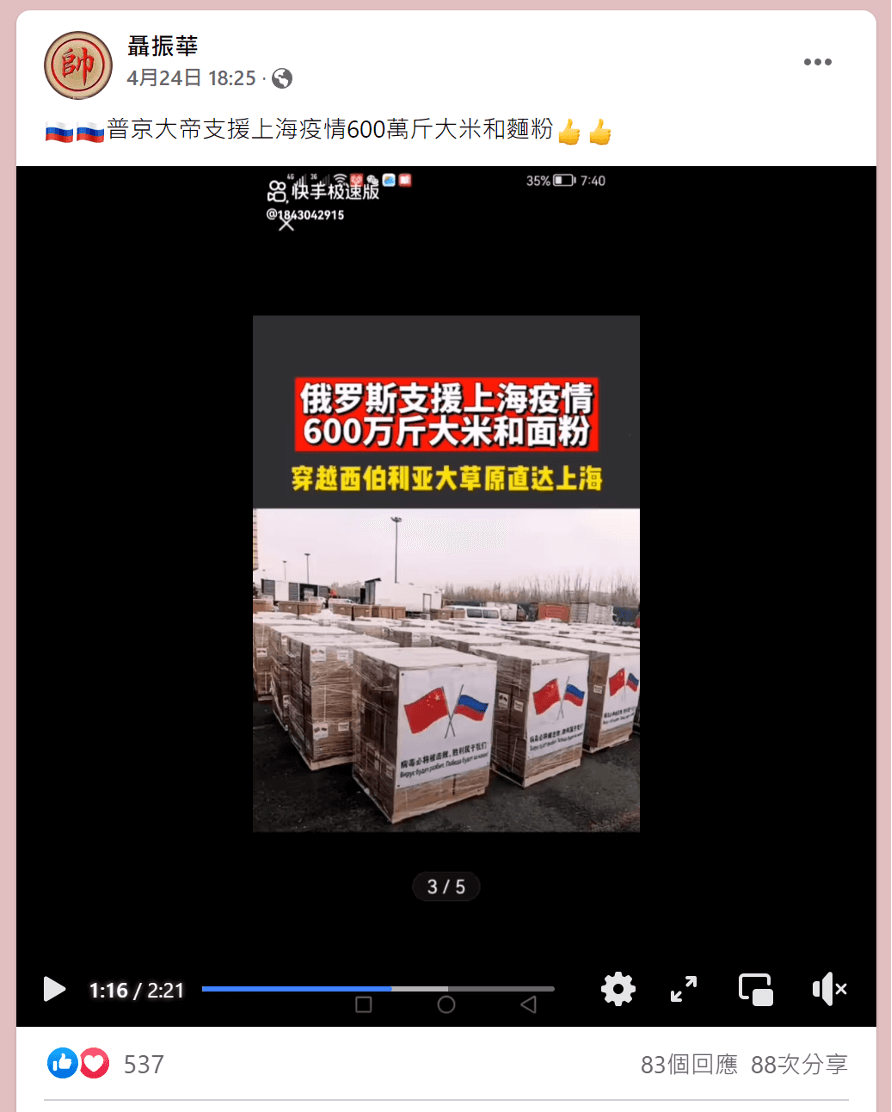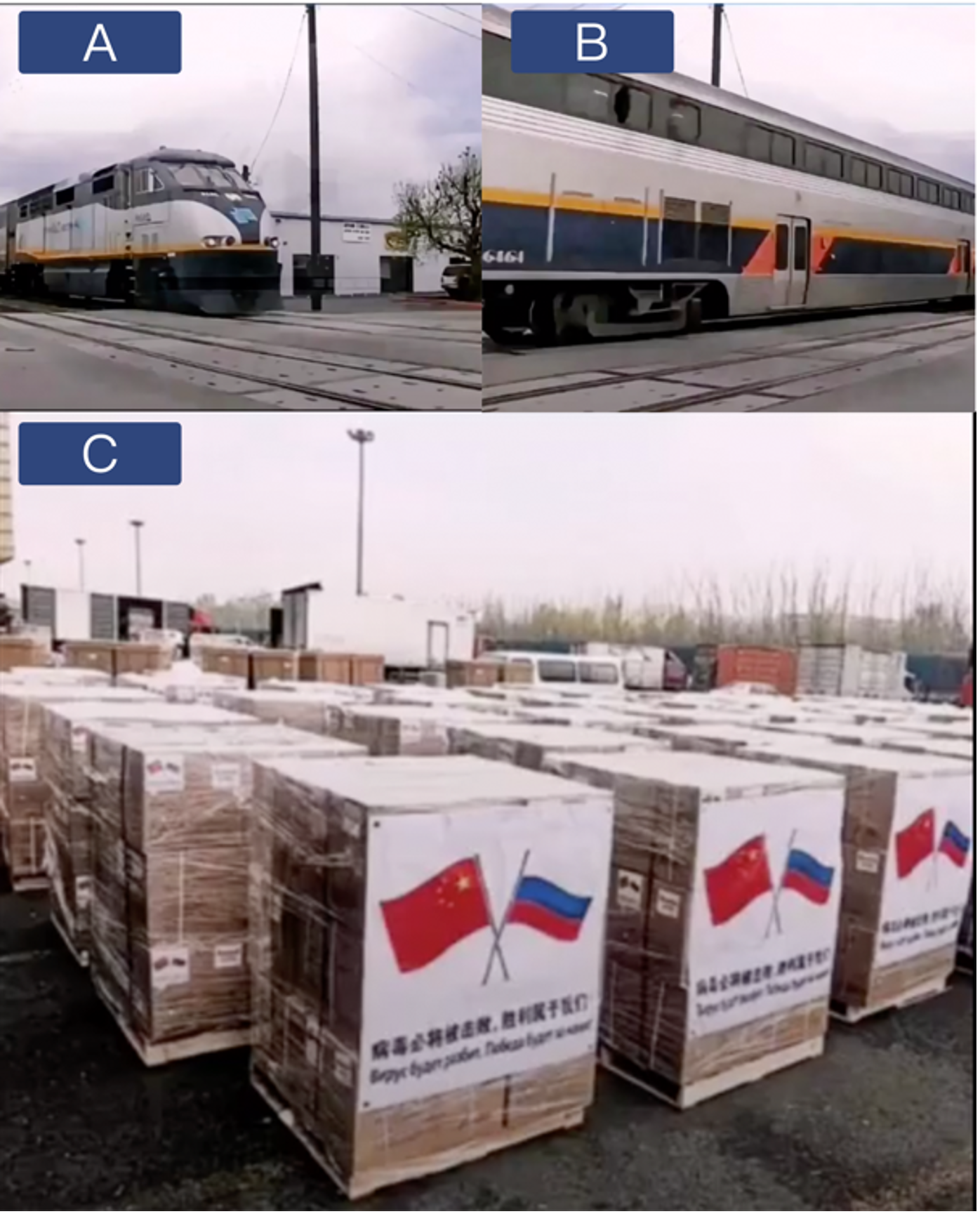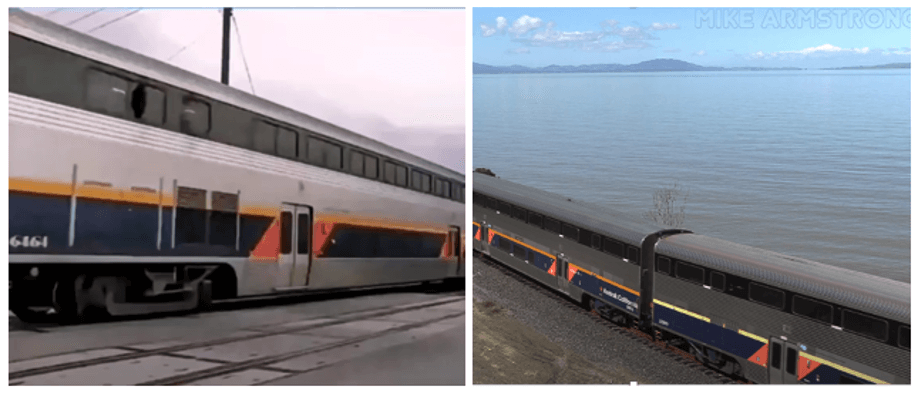Publish Date (HKT) 2022-05-25
This video does not show Russia providing aid to Shanghai during the city’s COVID-19 outbreak
Screenshot of the Facebook post.
(*Click to view larger image)
The Claim and Our Verdict
- Fact-checking:
- During the surge of COVID-19 cases in Shanghai, a Facebook post with a video, containing five different photos, claims to show a donation of aid supplies from Russia for the city. However, two of the photos of trains show railcars and a locomotive owned by Amtrak California, which only operates railway routes within the U.S. state of California. Therefore, the trains in the photos could not have been used to transport the supplies from Russia to Shanghai. A third photo of aid supplies shows the Chinese government’s donation of supplies to Russia in April 2020, not Russia’s aid to Shanghai.
- Additional keyword searches on Chinese and Russian state-run media organizations, including People’s Daily, Xinhua News Agency, TASS News Agency, and Sputnik, did not produce any information about, “Russia provides three million kilograms of rice and flour to Shanghai to support the city’s anti-pandemic efforts.”
- Our verdict: This video does not show Russia’s aid to Shanghai during the city’s COVID-19 outbreak.
News Brief
Beginning March 2022, a surge of COVID-19 cases hit Shanghai, China’s largest city. The government responded with a citywide lockdown to curb the pandemic. During the city’s COVID-19 outbreak, a video posted April 24, 2022, on Facebook, claims to show Russia providing aid to Shanghai. The video contains five photos with superimposed captions written in simplified Chinese. The captions translate into English as: “Russia provides three million kilograms of rice and flour to support Shanghai’s fight against the pandemic. The aid supplies traveled across the Siberian steppe to Shanghai.”
As of the publication of the report, the video had been viewed 253 times, and the post had received 83 comments and 537 likes or reactions.
Fact-checking
Three of the five photos in the video are labeled as A, B and C for easy reference.
The three photos are labelled as A, B, and C.
(*Click to view larger image)
A reverse image search found that the locomotive, shown in photo A, belongs to Amtrak California. A similar image of a locomotive with a corresponding exterior paint design and an original Amtrak California logo was found on the company’s official Twitter account. The Amtrak California logo shown in photo A was inverted horizontally. The locomotive shown in photo A, therefore, is owned by Amtrak California.
A comparison between the photo shared in the Facebook video (left) and the image found on Amtrak California’s official Twitter account (right).
(*Click to view larger image)
A reverse image search of photo B found a YouTube video published April 27, 2019, titled “Amtrak California Trains!” At the 1:40 mark of the video, the railcar’s exterior paint design is similar to that of the railcar in photo B. In addition, the company’s name “Amtrak California” can be seen written on the train’s exterior. Therefore, the railcar, as shown in photo B, is owned by Amtrak California as well.
A comparison between photo B and the 1:40 mark screenshot of the YouTube video.
(*Click to view larger image)
The company’s name “Amtrak California” can be seen on the railcar’s paint design in the YouTube video.
(*Click to view larger image)
According to Amtrak’s official website, under the Amtrak California banner, the California Department of Transportation (Caltrans) funds three of the five busiest intercity passenger rail routes in the Amtrak system, i.e., the Pacific Surfliner, the Capitol, and the San Joaquin. Caltrans manages both the Pacific Surfliner and San Joaquin. The abovementioned three passenger routes are being operated within the U.S., according to information on Amtrak’s official website (Pacific Surfliner, Capitol Corridor, San Joaquin). Keyword searches do not produce any information claiming Amtrak operates rail routes outside the U.S. The locomotive and railcars shown in photos A and B, therefore, could not have traveled across the Siberian steppe to Shanghai.
A comparison between Photo C (left) and the photo published with the CCTV article (right).
(*Click to view larger image)
To sum up, photos A, B and C are all used with false contextual information. They do not show Russia’s aid supplies to China as purported in the claim.
Further keyword searches on Chinese and Russian state-run media organizations, including People’s Daily, Xinhua New Agency, TASS News Agency, and Sputnik, did not produce any information about, “Russia provides three million kilograms of rice and flour to Shanghai to support the city’s anti-pandemic efforts.”
Conclusion
Therefore, the video published on Facebook does not show Russian aid to Shanghai during the city’s COVID-19 outbreak.
References
- Facebook, post, April 24, 2022.
- Amtrak California, Twitter.
- YouTube, video, April 27, 2019.
- Amtrak, “AMTRAK ADDS CAPACITY TO CALIFORNIA TRAINS FOR THANKSGIVING,” Nov. 20, 2014.
- Amtrak, Pacific Surfliner.
- Amtrak, Capitol Corridor.
- Amtrak, San Joaquin.
- CCTV, “Medical face masks and hazmat suits… China’s donation of anti-pandemic supplies departed Beijing for Russia,” April 2, 2020.


















 :
:  : 3411 7375
: 3411 7375 :
: